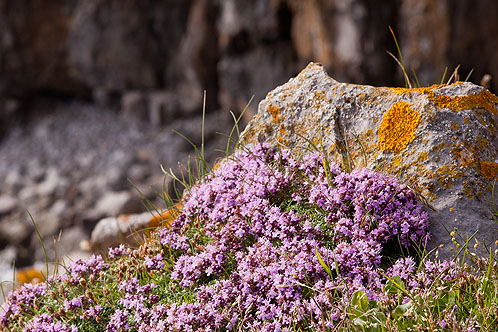
Wild thyme is native to the Palearctic realm of Europe and Asia. The fruit is a dry, four-chambered schizocarp. Each flower has four projecting stamens and two fused carpels. The upper petal is notched and the lower one is larger than the two lateral petals and has three flattened lobes which form a lip. The usually pink or mauve flowers have a tube-like calyx and an irregular straight-tubed, hairy corolla. The plant sends up erect flowering shoots in summer. The leaves are in opposite pairs, nearly stalkless, with linear elliptic round-tipped blades and untoothed margins. It forms matlike plants that root from the nodes of the squarish, limp stems. Wild thyme is a creeping dwarf evergreen shrub with woody stems and a taproot. The hardy plant tolerates some pedestrian traffic and produces odors ranging from heavily herbal to lightly lemon, depending on the variety. The strongly scented flowers are either lilac, pink-purple, magenta, or a rare white, all 4–6 mm long and produced in clusters. The oval evergreen leaves are 3–8 mm long. It is a low, usually prostrate subshrub growing to 2 cm (1 in) tall with creeping stems up to 10 cm (4 in) long.

Thymus serpyllum, known by the common names of Breckland thyme, Breckland wild thyme, wild thyme, creeping thyme, or elfin thyme, is a species of flowering plant in the mint family Lamiaceae, native to most of Europe and North Africa. Thymus subhirsutus Borbás & Heinr.Braun.


 0 kommentar(er)
0 kommentar(er)
